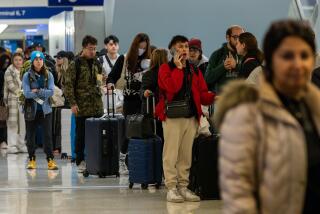Flu Taxes Hospitals
- Share via
Southern California hospitals are scrambling to treat flu patients and victims of respiratory disease amid a growing shortage of nurses and hospital beds.
Feverish patients are waiting as long as six hours to be seen in some emergency rooms, and doctors fear that the wait will only grow as the flu season peaks in coming weeks. Ambulances have increasingly been diverted from overwhelmed hospitals to facilities that aren’t as busy.
“We’ve been really worrying about this flu epidemic and surely it’s hitting now,” said Dr. Daniel Higgins, medical director of the emergency department of St. Francis Medical Center in Lynwood. “In the past we’ve had viral infections combined with the flu that have devastated emergency departments. We are on the verge of that now.”
During a normal flu season, one in five or six visitors to hospital emergency rooms comes in with flu-like symptoms, said Jim Lott, executive vice president of the Health Care Assn. of Southern California, a hospital trade group. This season, he said, it has been more like one in four.
Most nurses in Southern California hospitals have been working overtime or skipping vacations and holidays to accommodate the influx of patients, he said. And many hospitals have hired temporary nurses to help.
Compared to a year ago, some emergency rooms report seeing 30% to 40% more patients with flu-like symptoms, said Alicia Gonzalez, a spokeswoman for private hospitals in Glendale, East Los Angeles and Simi Valley.
“They are seeing very sick people,” Gonzalez said. “People are coming in with fevers of 103 and 104.”
This flu season was dreaded even before it began. The manufacture of influenza vaccine was delayed for weeks, and then supplies were unevenly distributed. Doctors worried that their most vulnerable patients would not get protection in time and accused some distributors of price gouging.
It remains unclear whether this season will shape up to be worse than previous years--but the surge of flu in the last two weeks has certainly fueled physicians’ and patients’ anxieties.
“It’s a little early [to tell],” said Dr. Richard Stringham, a Northridge family practitioner. “It seems to hit here full force near the middle of January. . . . In recent years, I thought it was going to be an easy year, then it hits like wildfire. I’ve seen it happen in a weekend.”
Virginia Hastings, director of emergency medical services for Los Angeles County, said the diversion of ambulances increased significantly between November and December but the rate was not as high as in the previous year at the same time.
“Certainly the diversion [is] up because the [emergency rooms] are busier, and they seem to be busier because of flu-type symptoms,” she said.
Higgins said his emergency room has been seeing nearly 200 patients per day in the last two weeks, up from about 150 on a normal day. More children have been brought in with flu-like symptoms such as fever, fatigue and aches, and some have had problems with nausea, vomiting, diarrhea or dehydration, he said.
He said St. Francis does not have enough nurses to staff the beds in the hospital. Sick people have waited for beds for as long as six hours.
“We don’t even have enough [nurses] to staff the emergency department,” he said.
Kay McVay, president of the California Nurses Assn., said hospitals that are hiring temporary nursing staff members are only putting a Band-Aid on the problem. The nation is facing a long-standing, severe nursing shortage that the flu season only aggravates, she said.
“I think the hospital industry will blame the nurses for not being there but will not assume any responsibility,” she said. “We are in a crisis. . . . There is a nursing shortage and no one’s really addressing it.”
The nursing shortage has grown worse in the last decade as hospitals downsized, managed care increased workloads, more nurses retired and young women chose other--often less taxing--careers.
Hospitals are not the only fronts in the flu war. In fact, health officials encourage flu patients to visit their family doctors or pharmacists rather than emergency rooms.
While the flu can be serious--even fatal--for the elderly and those with asthma or weak immune systems, it generally does not warrant a hospital visit. General practitioners can prescribe medications that, if administered soon after flu symptoms appear, can help battle the illness.
At a Canoga Park pediatrics office Wednesday, the appointment book was full. “They’re all thinking that we can cure it,” nurse Judy Nahan said. “I wish I could.”
Flu vaccination shots can prevent the flu, or at least ease its symptoms.
Nationwide, influenza of one strain or another is associated with 20,000 deaths each year and more than 100,000 hospitalizations, according to the Centers for Disease Control and Prevention in Atlanta. The most flu cases are seen in urban areas, where dense populations spread airborne viruses faster than in less crowded areas.
More to Read
Sign up for Essential California
The most important California stories and recommendations in your inbox every morning.
You may occasionally receive promotional content from the Los Angeles Times.










